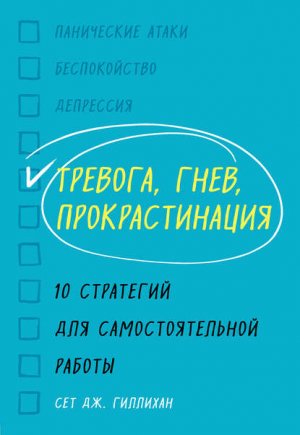Тревога, гнев, прокрастинация. 10 стратегий для самостоятельной работы Гиллихан Сет

Американская ассоциация исследования осознанности (amra)
www.goamra.org. Сайт AMRA публикует последние исследования, посвященные практике осознанности, а также интерактивную карту для поиска тренингов по осознанности.
Mindfulnet
www.mindfulnet.org/index.htm. Данный сайт – это центр справочной информации по осознанности: что такое осознанность, как ей пользоваться, исследования, лежащие в основе, и многое другое.
Книги
Многие из этих книг находятся в списке литературы, одобренном Ассоциацией поведенческой и когнитивной терапии, что означает, что в них опубликованы способы лечения, имеющие под собой внушительную исследовательскую базу. Полный список публикуется на сайте www.abct.org/SHBooks.
ЗАВИСИМОСТЬ
Anderson, Kenneth. How to Change Your Drinking: A Harm Reduction Guide to Alcohol, 2010.
Glasner-Edwards, Suzette. The Addiction Recovery Skills Workbook: Changing Addictive Behaviors Using CBT, Mindfulness, and Motivational Interviewing Techniques, 2015.
Williams, Rebecca E., and Julie S. Kraft. The Mindfulness Workbook for Addiction: A Guide to Coping with the Grief, Stress and Anger That Trigger Addictive Behaviors, 2012.
Wilson, Kelley, and Troy DuFrene. The Wisdom to Know the Dierence: An Acceptance and Commitment Therapy Workbook for Overcoming Substance Abuse, 2012.
ГНЕВ
Мак-Кей М., Роджерс П. Укрощение гнева, 1997.
Karmin, Aaron. Anger Management Workbook for Men: Take Control of Your Anger and Master Your Emotions, 2016.
Potter-Efron, Ronald. Rage: A Step-by-Step Guide to Overcoming Explosive Anger, 2016.
Sche, Leonard, and Susan Edmiston. The Cow in the Parking Lot: A Zen Approach to Overcoming Anger, 2010.
ТРЕВОГА
Antony, Martin M., and Richard P. Swinson. The Shyness and Social Anxiety Workbook: Proven Techniques for Overcoming Your Fears, 2010.
Carbonell, David. Panic Attacks Workbook: A Guided Program for Beating the Panic Trick, 2004.
Clark, David A., and Aaron T. Beck. The Anxiety and Worry Workbook: The Cognitive Behavioral Solution, 2011.
Cuncic, Arlin. The Anxiety Workbook: A 7-Week Plan To Overcome Anxiety, Stop Worrying, and End Panic, 2017.
Robichaud, Melisa, and Michel J. Dugas. The Generalized Anxiety Disorder Workbook: A Comprehensive CBT Guide for Coping with Uncertainty, Worry, and Fear, 2015.
Tolin, David. Face Your Fears: A Proven Plan to Beat Anxiety, Panic, Phobias and Obsessions, 2012.
Tompkins, Michael A. Anxiety and Avoidance: A Universal Treatment for Anxiety, Panic, and Fear, 2013.
ПОВЫШЕНИЕ УВЕРЕННОСТИ В СЕБЕ
Алберти Р., Эммонс М. Твое абсолютное право. Ассертивность и равенство в вашей жизни и отношениях, 2009.
Vavrichek, Sherrie. The Guide to Compassionate Assertiveness: How to Express Your Needs and Deal with Conict While Keeping a Kind Heart, 2012.
ДЕПРЕССИЯ
Гринбергер Д., Падески К. Разум рулит настроением. Измени свои мысли, привычки, здоровье, жизнь, 2019.
Addis, Michael E., and Christopher R. Martell. Overcoming Depression One Step at a Time: The New Behavioral Activation Approach to Getting Your Life Back, 2004.
Burns, David D. The Feeling Good Handbook, Revised edition, 1999.
Joiner, Thomas Jr., and Jeremy Pettit. The Interpersonal Solution to Depression: A Workbook for Changing How You Feel by Changing How You Relate, 2005.
Rego, Simon, and Sarah Fader. The 10-Step Depression Relief Workbook: A Cognitive Behavioral Therapy Approach, 2018.
ДЕПРЕССИЯ И ТРЕВОГА
Маккей М., Дэвис М., Эшельман Э. Релаксация и снятие стресса. Рабочая тетрадь, 2019.
Ellis, Albert, and Robert A. Harper. A New Guide to Rational Living, 1961.
Gillihan, Seth J. Retrain Your Brain: Cognitive Behavioral Therapy in 7 Weeks: A Workbook for Managing Depression and Anxiety, 2016.
Otto, Michael, and Jasper Smits. Exercise for Mood and Anxiety: Proven Strategies for Overcoming Depression and Enhancing Well-Being, 2011.
ОСОЗНАННОСТЬ
Брах Т. Радикальное принятие. Как исцелить психологическую травму и посмотреть на свою жизнь взглядом Будды, 2018.
Орсильо С., Ремер Л. Осознанность или тревога. Перестань беспокоиться и верни себе свою жизнь, 2019.
Солзберг Ш. Любящая доброта. Искусство быть счастливым, 2016.
Тисдейл Дж., Сигал З. Выход из депрессии. Освободите себя от хронической неудовлетворенности, 2009.
Germer, Christopher K. The Mindful Path to Self-Compassion: Freeing Yourself from Destructive Thoughts and Emotions, 2009.
Kabat-Zinn, Jon. Full Catastrophe Living: Using the Wisdom of Your Body and Mind to Face Stress, Pain, and Illness, Revised edition, 2013.
ОТНОШЕНИЯ
Руис М. Мастерство любви, 2011.
Gottman, John, and Joan DeClaire. The Relationship Cure: A Five-Step Guide to Strengthening Your Marriage, Family, and Friendships, 2001.
McKay, Matthew, Patrick Fanning, and Kim Paleg. Couple Skills: Making Your Relationship Work, 1994.
Richo, David. How to Be an Adult in Relationships: The Five Keys to Mindful Loving, 2002.
ЗАБОТА О СЕБЕ
Браун Б. Дары несовершенства. Как полюбить себя таким, какой ты есть, 2019.
Ne, Kristin. Self-Compassion: The Proven Power of Being Kind to Yourself, 2011.
СОН
Carney, Colleen. Quiet Your Mind and Get to Sleep: Solutions to Insomnia for Those with Depression, Anxiety, or Chronic Pain, 2009.
Ehrnstrom, Colleen, and Alisha L. Brosse. End the Insomnia Struggle: A Step-by-Step Guide to Help You Get to Sleep and Stay Asleep, 2016.
Библиография
Бек А., Раш А., Шо Б., Эмери Г. Когнитивная терапия депрессии. СПб.: Питер, 2013
Бек Д. Когнитивная терапия. Полное руководство. М.: Вильямс, 2018.
Грант А. Оригиналы. Как нонконформисты двигают мир вперед. М.: Corpus, 2019.
Карсон Р. Безмолвная весна. М.: Прогресс, 1965.
Сапольски Р. Почему у зебр не бывает инфаркта. Психология стресса. СПб.: Питер, 2018.
Уильям Дж. Воля к вере. Человеческая энергия. М.: Республика, 1997.
Akbaraly, Tasnime N., Eric J. Brunner, Jane E. Ferrie, Michael G. Marmot, Mika Kivimki, and Archana Singh-Manoux. “Dietary Pattern and Depressive Symptoms in Middle Age.” The British Journal of Psychiatry 195, no. 5 (October 2009): 408–413. doi: 10.1192/bjp.bp.108.058925.
Akbaraly, Tasnime N., Clarisse Kerleau, Marilyn Wyart, Nathalie Chevallier, Louise Ndiaye, Nitin Shivappa, James R. Hbert, and Mika Kivimki. “Dietary Inammatory Index and Recurrence of Depressive Symptoms: Results from the Whitehall II Study.” Clinical Psychological Science 4, no. 6 (November 2016): 1125–1134. doi: 10.1177/2167702616645777.
Alcock, Ian, Mathew P. White, Benedict W. Wheeler, Lora E. Fleming, and Michael H. Depledge. “Longitudinal Eects on Mental Health of Moving to Greener and Less Green Urban Areas.” Environmental Science & Technology 48, no. 2 (2014): 1247–1255. doi: 10.1021/es403688w.
American Psychiatric Association. Diagnostic and Statistical Manual of Mental Disorders, 5th ed. (DSM-5). Arlington, VA: American Psychiatric Association Publishing, 2013.
Anderson, Kristen Joan. “Impulsivity, Caeine, and Task Diculty: A Within-Subjects Test of the Yerkes – Dodson Law.” Personality and Individual Dierences 16, no. 6 (June 1994): 813–829. doi: 10.1016/0191 -8869(94)90226-7.
Arias-Carrin, Oscar, Maria Stamelou, Eric Murillo-Rodrguez, Manuel Menndez-Gonzlez, and Ernst Pppel. “Dopaminergic Reward System: A Short Integrative Review.” International Archives of Medicine 3, no. 1 (2010): 24. doi: 10.1186/1755-7682-3-24.
Asmundson, Gordon J. G., Mathew G. Fetzner, Lindsey B. DeBoer, Mark B. Powers, Michael W. Otto, and Jasper A. J. Smits. “Let’s Get Physical: A Contemporary Review of the Anxiolytic Eects of Exercise for Anxiety and Its Disorders.” Depression and Anxiety 30, no. 4 (April 2013): 362–373. doi:10.1002/da.22043.
Barlow, David H., Jack M. Gorman, M. Katherine Shear, and Scott W. Woods. “Cognitive-Behavioral Therapy, Imipramine, or Their Combination for Panic Disorder: A Randomized Controlled Trial.” Journal of the American Medical Association 283, no. 19 (200): 2529–2536. doi: 10.1001/jama.283.19.2529.
Barth, Jrgen, Martina Schumacher, and Christoph Herrmann- Lingen. “Depression as a Risk Factor for Mortality in Patients with Coronary Heart Disease: A Meta-Analysis.” Psychosomatic Medicine 66, no. 6 (November/December 2004): 802–813. doi: 10.1097/ 01.psy.0000146332.53619.b2.
Bartlett, Monica Y., and David DeSteno. “Gratitude and Prosocial Behavior: Helping When It Costs You.” Psychological Science 17, no. 4 (April 2006): 319–325. doi: 10.1111/j.1467–9280.2006.01705.x.
Be, Daniel, Mark A. Whisman, and Lisa A. Uebelacker. “Prospective Associations Between Marital Adjustment and Life Satisfaction.” Personal Relationships 20, no. 4 (December 2013): 728–739. doi: 10.1111/pere.12011.
Beck, Aaron T. Cognitive Therapy and the Emotional Disorders. New York: Penguin Books, 1979.
Beck, Aaron T. Prisoners of Hate: The Cognitive Basis of Anger, Hostility, and Violence. New York: HarperCollins Publishers, 1999.
Beck, Aaron T., Andrew C. Butler, Gregory K. Brown, Katherine K. Dahlsgaard, Cory F. Newman, and Judith S. Beck. “Dysfunctional Beliefs Discriminate Personality Disorders.” Behaviour Research and Therapy 39, no. 10 (2001): 1213–1225.
Beck, Richard, and Ephrem Fernandez. “Cognitive-Behavioral Therapy in the Treatment of Anger: A Meta-Analysis.” Cognitive Therapy and Research 22, no. 1 (February 1998): 63–74.
Bergmans, Rachel S., and Kristen M. Malecki. “The Association of Dietary Inammatory Potential with Depression and Mental Well-Being Among US Adults.” Preventive Medicine 99 (March 2017): 313–319. doi: 10.1016/ j.ypmed.2017.03.016.
Bratman, Gregory N., J. Paul Hamilton, Kevin S. Hahn, Gretchen C. Daily, and James J. Gross. “Nature Experience Reduces Rumination and Subgenual Prefrontal Cortex Activation.” Proceedings of the National Academy of Sciences 112, no. 28 (July 2015): 8567–8572. doi: /10.1073/ pnas.1510459112.
Brown, Daniel K., Jo L. Barton, and Valerie F. Gladwell. “Viewing Nature Scenes Positively Aects Recovery of Autonomic Function Following Acute-Mental Stress.” Environmental Science & Technology 47, no. 11 (June 2013): 5562–5569. doi: 10.1021/es305019p.
Brown, Emma M., Debbie M. Smith, Tracy Epton, and Christopher J. Armitage. “Do Self-Incentives Change Behavior? A Systematic Review and Meta-Analysis.” Behavior Therapy 49, no. 1 (2018): 113–123. doi: 10.1016/j.beth.2017.09.004.
Burns, David D. The Feeling Good Handbook. New York: Plume/Penguin Books, 1999.
Chiesa, Alberto, and Alessandro Serretti. “Mindfulness-Based Stress Reduction for Stress Management in Healthy People: A Review and Meta-Analysis.” The Journal of Alternative and Complementary Medicine 15, no. 5 (May 2009): 593–600. doi: 10.1089/acm.2008.0495.
Cooney, Gary M., Kerry Dwan, Carolyn A. Greig, Debbie A. Lawlor, Jane Rimer, Fiona R. Waugh, Marion McMurdo, and Gillian E. Mead. “Exercise for Depression.” Cochrane Database of Systematic Reviews, no. 9 (September 2013). doi:10.1002/14651858.CD004366.pub6.
Craske, Michelle G., and David H. Barlow. Mastery of Your Anxiety and Panic: Workbook, 4th ed. New York: Oxford University Press, 2006.
Crocker, Jennifer, and Amy Canevello. “Creating and Undermining Social Support in Communal Relationships: The Role of Compassionate and Self-Image Goals.” Journal of Personality and Social Psychology 95, no. 3 (September 2008): 555–575. doi: 10.1037/0022-3514.95.3.555.
Cuijpers, Pim, Tara Donker, Annemieke van Straten, J. Li, and Gerhard Andersson. “Is Guided Self-Help as Eective as Face-to-Face Psychotherapy for Depression and Anxiety Disorders? A Systematic Review and Meta-Analysis of Comparative Outcome Studies.” Psychological Medicine 40, no. 12 (December 2010): 1943–1957. doi: 10.1017/ S0033291710000772.
Davis, Daphne M., and Jerey A. Hayes. “What Are the Benets of Mindfulness? A Practice Review of Psychotherapy-Related Research.” Psychotherapy 48, no. 2 (2011): 198–208.
Derks, Daantje, and Arnold B. Bakker. “Smartphone Use, Work – Home Interference, and Burnout: A Diary Study on the Role of Recovery.” Applied Psychology 63, no. 3 (July 2014): 411–440. doi: 10.1111/j.1464–0597.2012.00530.x.
DeRubeis, Robert J., Steven D. Hollon, Jay D. Amsterdam, Richard C. Shelton, Paula R. Young, Ronald M. Salomon, John P. O’Reardon, Margaret L. Lovett, Madeline M. Gladis, Laurel L. Brown, and Robert Gallop. “Cognitive Therapy vs Medications in the Treatment of Moderate to Severe Depression.” Archives of General Psychiatry 62, no. 4 (2005): 409–416. doi: 10.1001/archpsyc.62.4.409.
DeRubeis, Robert J., Christian A. Webb, Tony Z. Tang, and Aaron T. Beck. “Cognitive Therapy.” In Handbook of Cognitive-Behavioral Therapies, 3rd ed. edited by Keith S. Dobson, pp. 349–392. New York: Guilford Press, 2001.
Diamond, David M., Adam M. Campbell, Collin R. Park, Joshua Halonen, and Phillip R. Zoladz. “The Temporal Dynamics Model of Emotional Memory Processing: A Synthesis on the Neurobiological Basis of Stress-Induced Amnesia, Flashbulb and Traumatic Memories, and the Yerkes – Dodson Law.” Neural Plasticity (2007). doi: 10.1155/2007/60803.
Division 12 of the American Psychological Association. “Research- Supported Psychological Treatments.” Accessed November 15, 2017. https://www.div12.org/psychological-treatments.
Ekers, David, Lisa Webster, Annemieke Van Straten, Pim Cuijpers, David Richards, and Simon Gilbody. “Behavioural Activation for Depression: An Update of Meta-Analysis of Eectiveness and Sub Group Analysis.” PloS One 9, no. 6 (June 2014): e100100. doi: 10.1371/journal.pone.0100100.
Ellenbogen, Jerey M., Jessica D. Payne, and Robert Stickgold. “The Role of Sleep in Declarative Memory Consolidation: Passive, Permissive, Active or None?” Current Opinion in Neurobiology 16, no. 6 (December 2006): 716–722. doi: 10.1016/j.conb.2006.10.006.
Ellis, Albert. Reason and Emotion in Psychotherapy. Secaucus, NJ: Citadel Press, 1962.
Emmons, Robert A., and Michael E. McCullough. “Counting Blessings Versus Burdens: An Experimental Investigation of Gratitude and Subjective Well-Being in Daily Life.” Journal of Personality and Social Psychology 84, no. 2 (February 2003): 377–389.
Erickson, Thane M., M. Teresa Granillo, Jennifer Crocker, James L. Abelson, Hannah E. Reas, and Christina M. Quach. “Compassionate and Self-Image Goals as Interpersonal Maintenance Factors in Clinical Depression and Anxiety.” Journal of Clinical Psychology (September 2017) doi: 10.1002/jclp.22524.
Felmingham, Kim, Andrew Kemp, Leanne Williams, Pritha Das, Gerard Hughes, Anthony Peduto, and Richard Bryant. “Changes in Anterior Cingulate and Amygdala After Cognitive Behavior Therapy of Posttraumatic Stress Disorder.” Psychological Science 18, no. 2 (February 2007): 127–129.
Fox, Jesse, and Jennifer J. Moreland. “The Dark Side of Social Networking Sites: An Exploration of the Relational and Psychological Stressors Associated with Facebook Use and Aordances.” Computers in Human Behavior 45 (April 2015): 168–176. doi: 10.1016/j.chb.2014.11.083.
Francis, Kylie, and Michel J. Dugas. “Assessing Positive Beliefs About Worry: Validation of a Structured Interview.” Personality and Individual Dierences 37, no. 2 (July 2004): 405–415. doi: 10.1016/j.paid.2003.09.012.
Gillihan, Seth J., John A. Detre, Martha J. Farah, and Hengyi Rao. “Neural Substrates Associated with Weather-Induced Mood Variability: An Exploratory Study Using ASL Perfusion fMRI.” Journal of Cognitive Science 12, no. 2 (2011): 195–210.
Gillihan, Seth J., Hengyi Rao, Jiongjiong Wang, John A. Detre, Jessica Breland, Geena Mary V. Sankoorikal, Edward S. Brodkin, and Martha J. Farah. “Serotonin Transporter Genotype Moduates Amygdala Activity During Mood Regulation.” Social Cognitive and Aective Neuroscience 5, no. 1 (March 2010): 1–10. doi: 10.1093/scan/nsp035.
Gillihan, Seth J., Chenjie Xia, Alisa A. Padon, Andrea S. Heberlein, Martha J. Farah, and Lesley K. Fellows. “Contrasting Roles for Lateral and Ventromedial Prefrontal Cortex in Transient and Dispositional Aective Experience.” Social Cognitive and Aective Neuroscience 6, no. 1 (January 2011): 128–137. doi: 10.1093/scan/nsq026.
Grant, Joshua A., Emma G. Duerden, Jrme Courtemanche, Mariya Cherkasova, Gary H. Duncan, and Pierre Rainville. “Cortical Thickness, Mental Absorption and Meditative Practice: Possible Implications for Disorders of Attention.” Biological Psychology 92, no. 2 (2013): 275–281.
Hartig, Terry, Richard Mitchell, Sjerp De Vries, and Howard Frumkin. “Nature and Health.” Annual Review of Public Health 35 (2014): 207–228. doi: 10.1146/annurev-publhealth-032013-182443.
Hellstrm, Kerstin, and Lars-Gran st. “One-Session Therapist Directed Exposure vs Two Forms of Manual Directed Self-Exposure in the Treatment of Spider Phobia.” Behaviour Research and Therapy 33, no. 8 (November 1995): 959–965. doi: 1016/0005-7967(95)00028-V.
Hirshkowitz, Max, Kaitlyn Whiton, Steven M. Albert, Cathy Alessi, Oliviero Bruni, Lydia DonCarlos, Nancy Hazen, et al. “National Sleep Foundation’s Sleep Time Duration Recommendations: Methodology and Results Summary.” Sleep Health 1, no. 1 (2015): 40–43. doi: 10.1016/ j.sleh.2014.12.010.
Hofmann, Stefan G., Anu Asnaani, Imke J. J. Vonk, Alice T. Sawyer, and Angela Fang. “The Ecacy of Cognitive Behavioral Therapy: A Review of Meta-Analyses.” Cognitive Therapy and Research 36, no. 5 (October 2012): 427–440. doi: 10.1007/s10608-012-9476-1.
Hofmann, Stefan G., Alice T. Sawyer, Ashley A. Witt, and Diana Oh. “The Eect of Mindfulness-Based Therapy on Anxiety and Depression: A Meta-Analytic Review.” Journal of Consulting and Clinical Psychology 78, no. 2 (April 2010): 169–183. doi: 10.1037/a0018555.
Hollon, Steven D., Robert J. DeRubeis, Richard C. Shelton, Jay D. Amsterdam, Ronald M. Salomon, John P. O’Reardon, Margaret L. Lovett, et al. “Prevention of Relapse Following Cognitive Therapy vs Medications in Moderate to Severe Depression.” Archives of General Psychiatry 62, no. 4 (April 2005): 417–422. doi:10.1001/archpsyc.62.4.417.
Irwin, Michael R., Minge Wang, Capella O. Campomayor, Alicia Collado-Hidalgo, and Steve Cole. “Sleep Deprivation and Activation of Morning Levels of Cellular and Genomic Markers of Inammation.” Archives of Internal Medicine 166, no. 16 (2006): 1756–1762. doi: 10.1001/ archinte.166.16.1756.
Jacka, Felice N., Julie A. Pasco, Arnstein Mykletun, Lana J. Williams, Allison M. Hodge, Sharleen Linette O’Reilly, Georey C. Nicholson, Mark A. Kotowicz, and Michael Berk. “Association of Western and Traditional Diets with Depression and Anxiety in Women.” American Journal of Psychiatry 167, no. 3 (March 2010): 305–311. doi: 10.1176/ appi.ajp.2009.09060881.
Jeanne, Miranda, James J. Gross, Jacqueline B. Persons, and Judy Hahn. “Mood Matters: Negative Mood Induction Activates Dysfunctional Attitudes in Women Vulnerable to Depression.” Cognitive Therapy and Research 22, no. 4 (August 1998): 363–376. doi: 10.1023/A:1018709212986.
Kabat-Zinn, Jon, Leslie Lipworth, and Robert Burney. “The Clinical Use of Mindfulness Meditation for the Self-Regulation of Chronic Pain.” Journal of Behavioral Medicine 8, no. 2 (1985): 163–190.
Kaplan, Bonnie J., Julia J. Rucklidge, Amy Romijn, and Kevin McLeod. “The Emerging Field of Nutritional Mental Health: Inammation, the Microbiome, Oxidative Stress, and Mitochondrial Function.” Clinical Psychological Science 3, no. 6 (2015): 964–980.
Kessler, Ronald C., Patricia Berglund, Olga Demler, Robert Jin, Doreen Koretz, Kathleen R. Merikangas, A. John Rush, Ellen E. Walters, and Philip S. Wang. “The Epidemiology of Major Depressive Disorder: Results from the National Comorbidity Survey Replication (NCS-R).” Journal of the American Medical Association 289, no. 23 (June 2003): 3095–3105. doi: 10.1001/jama.289.23.3095.
Kessler, Ronald C., Patricia Berglund, Olga Demler, Robert Jin, Kathleen R. Merikangas, and Ellen E. Walters. “Lifetime Prevalence and Age-of-Onset Distributions of DSM-IV Disorders in the National Comorbidity Survey Replication.” Archives of General Psychiatry 62, no. 6 (June 2005): 593–602. doi: 10.1001/archpsyc.62.6.593.
Kessler, Ronald C., Wai Tat Chiu, Robert Jin, Ayelet Meron Ruscio, Katherine Shear, and Ellen E. Walters. “The Epidemiology of Panic Attacks, Panic Disorder, and Agoraphobia in the National Comorbidity Survey Replication.” Archives of General Psychiatry 63, no. 4 (April 2006): 415–424. doi:10.1001/archpsyc.63.4.415.
Kessler, Ronald C., Maria Petukhova, Nancy A. Sampson, Alan M. Zaslavsky, and Hans Ullrich Wittchen. “Twelve-Month and Lifetime Prevalence and Lifetime Morbid Risk of Anxiety and Mood Disorders in the United States.” International Journal of Methods in Psychiatric Research 21, no. 3 (September 2012): 169–184. doi:10.1002/mpr.1359.
Kessler, Ronald C., Ayelet Meron Ruscio, Katherine Shear, and Hans-Ulrich Wittchen. “Epidemiology of Anxiety Disorders.” In Behavioral Neurobiology of Anxiety and Its Treatment, edited by Murray B. Stein and Thomas Steckler, pp. 21–35. Heidelberg, Germany: Springer, 2009.
Krogh, Jesper, Merete Nordentoft, Jonathan A. C. Sterne, and Debbie A. Lawlor. “The Eect of Exercise in Clinically Depressed Adults: Systematic Review and Meta-Analysis of Randomized Controlled Trials.” The Journal of Clinical Psychiatry 72, no. 4 (April 2011): 529–538. doi: 10.4088 /JCP.08r04913blu.
Kross, Ethan, Philippe Verduyn, Emre Demiralp, Jiyoung Park, David Seungjae Lee, Natalie Lin, Holly Shablack, John Jonides, and Oscar Ybarra. “Facebook Use Predicts Declines in Subjective Well-Being in Young Adults.” PloS One 8, no. 8 (August 2013): e69841. doi: 10.1371 /journal.pone.0069841.
Lai, Jun S., Sarah Hiles, Alessandra Bisquera, Alexis J. Hure, Mark McEvoy, and John Attia. “A Systematic Review and Meta-Analysis of Dietary Patterns and Depression in Community-Dwelling Adults.” The American Journal of Clinical Nutrition 99, no. 1 (January 2014): 181–197. doi: 10.3945/ajcn.113.06988.
LeDoux, Joseph E. “Emotion: Clues from the Brain.” Annual Review of Psychology 46, no. 1 (1995): 209–235.
Lejuez, C. W., Derek R. Hopko, Ron Acierno, Stacey B. Daughters, and Sherry L. Pagoto. “Ten-Year Revision of the Brief Behavioral Activation Treatment for Depression: Revised Treatment Manual.” Behavior Modication 35, no. 2 (February 2011): 111–161.
Locke, Edwin A., and Gary P. Latham. “Building a Practically Useful Theory of Goal Setting and Task Motivation: A 35-Year Odyssey.” American Psychologist 57, no. 9 (2002): 705–717. doi: 10.1037/0003 -066X.57.9.705.
Ma, S. Helen, and John D. Teasdale. “Mindfulness-Based Cognitive Therapy for Depression: Replication and Exploration of Dierential Relapse Prevention Eects.” Journal of Consulting and Clinical Psychology 72, no. 1 (February 2004): 31–40. doi: 10.1037/0022-006X.72.1.31.
Minkel, Jared D., Siobhan Banks, Oo Htaik, Marisa C. Moreta, Christopher W. Jones, Eleanor L. McGlinchey, Norah S. Simpson, and David F. Dinges. “Sleep Deprivation and Stressors: Evidence for Elevated Negative Aect in Response to Mild Stressors When Sleep Deprived.” Emotion 12, no. 5 (October 2012): 1015–1020. doi: 10.1037/a0026871.
Mitchell, Matthew D., Philip Gehrman, Michael Perlis, and Craig A. Umscheid. “Comparative Eectiveness of Cognitive Behavioral Therapy for Insomnia: A Systematic Review.” BMC Family Practice 13 (May 2012): 1–11. doi: 10.1186/1471-2296-13-40.
Nelson, Julia, and Allison G. Harvey. “An Exploration of PreSeep Cognitive Activity in Insomnia: Imagery and Verbal Thought.” British Journal of Clinical Psychology 42, no. 3 (September 2003): 271–288.
Nemero, Charles B., J. Douglas Bremner, Edna B. Foa, Helen S. Mayberg, Carol S. North, and Murray B. Stein. “Posttraumatic Stress Disorder: A State-of-the-Science Review.” Journal of Psychiatric Research 40, no. 1 (2006): 1–21. doi: 10.1016/j.jpsychires.2005.07.005.
National Institute of Mental Health. “Mental Health Medications.” Accessed November 21, 2017. https://www.nimh.nih.gov/health/topics/mental-health-medications/index.shtml.
National Institute of Mental Health. “Mental Health Statistics.” Accessed November 10, 2017. https://www.nimh.nih.gov/health/topics/index.shtml.
O’Connell, Brenda H., Deirdre O’Shea, and Stephen Gallagher. “Feeling Thanks and Saying Thanks: A Randomized Controlled Trial Examining If and How Socially Oriented Gratitude Journals Work.” Journal of Clinical Psychology 73, no. 10 (October 2017): 1280–1300. doi: 10.1002/jclp.22469.
Opie, R. S., C. Itsiopoulos, N. Parletta, A. Snchez-Villegas, T. N. Akbaraly, Anu Ruusunen, and F. N. Jacka. “Dietary Recommendations for the Prevention of Depression.” Nutritional Neuroscience 20, no. 3 (April 2017): 161–171. doi: 10.1179/1476830515Y.0000000043.
st, Lars-Gran. “One-Session Treatment of Specic Phobias.” Behaviour Research and Therapy 27, no. 1 (February 1989): 1–7. doi: 10.1016/0005- 7967(89)90113-7.
Owen, John M. “Transdiagnostic Cognitive Processes in High Trait Anger.” Clinical Psychology Review 31, no. 2 (2011): 193–202. doi: 10.1016/ j.cpr.2010.10.003.
Parletta, Natalie, Dorota Zarnowiecki, Jihyun Cho, Amy Wilson, Svetlana Bogomolova, Anthony Villani, Catherine Itsiopoulos, et al. “A Mediterranean-Style Dietary Intervention Supplemented with Fish Oil Improves Diet Quality and Mental Health in People with Depression: A Randomized Controlled Trial (HELFIMED).” Nutritional Neuroscience (2017): 1–14.
Piet, Jacob, and Esben Hougaard. “The Eect of Mindfulness-Based Cognitive Therapy for Prevention of Relapse in Recurrent Major Depressive Disorder: A Systematic Review and Meta-Analysis.” Clinical Psychology Review 31, no. 6 (August 2011): 1032–1040. doi: 10.1016/j.cpr.2011.05.002.
Psychology Today. “Agoraphobia.” Accessed February 10, 2017. https://www.psychologytoday.com/conditions/agoraphobia.
Rahe, Corinna, and Klaus Berger. “Nutrition and Depression: Current Evidence on the Association of Dietary Patterns with Depression and Its Subtypes.” In Cardiovascular Diseases and Depression, pp. 279–304. Springer International Publishing, 2016.
Rao, Hengyi, Seth J. Gillihan, Jiongjiong Wang, Marc Korczykowski, Geena Mary V. Sankoorikal, Kristin A. Kaercher, Edward S. Brodkin, John A. Detre, and Martha J. Farah. “Genetic Variation in Serotonin Transporter Alters Resting Brain Function in Healthy Individuals.” Biological Psychiatry 62, no. 6 (2007): 600–606. doi: 10.1016/j.biopsych. 2006.11.028.
Raposa, Elizabeth B., Holly B. Laws, and Emily B. Ansell. “Prosocial Behavior Mitigates the Negative Eects of Stress in Everyday Life.” Clinical Psychological Science 4, no. 4 (2016): 691–698.
Rotenstein, Aliza, Harry Z. Davis, and Lawrence Tatum. “Early Birds Versus Just-in-Timers: The Eect of Procrastination on Academic Performance of Accounting Students.” Journal of Accounting Education 27, no. 4 (2009): 223–232. doi: 10.1016/j.jaccedu.2010.08.001.
Rucklidge, Julia J., and Bonnie J. Kaplan. “Nutrition and Mental Health.” Clinical Psychological Science 4, no. 6 (2016): 1082–1084.
Saini, Michael. “A Meta-Analysis of the Psychological Treatment of Anger: Developing Guidelines for Evidence-Based Practice.” Journal of the American Academy of Psychiatry and the Law Online 37, no. 4 (2009): 473–488.
Salzman, C. Daniel, and Stefano Fusi. “Emotion, Cognition, and Mental State Representation in Amygdala and Prefrontal Cortex.” Annual Review of Neuroscience 33 (2010): 173–202. doi: 10.1146/annurev.neuro. 051508.135256.
Snchez-Villegas, Almudena, Miguel Ruz-Canela, Alfredo Gea, Francisca Lahortiga, and Miguel A. Martnez-Gonzlez. “The Association Between the Mediterranean Lifestyle and Depression.” Clinical Psychological Science 4, no. 6 (2016): 1085–1093.
Segal, Zindel V., Michael Gemar, and Susan Williams. “Dierential Cognitive Response to a Mood Challenge Following Successful Cognitive Therapy or Pharmacotherapy for Unipolar Depression.” Journal of Abnormal Psychology 108, no. 1 (1999): 3–10. doi: 10.1037/0021-843X.108.1.3.
Seligman, Martin E. P., Tayyab Rashid, and Acacia C. Parks. “Positive Psychotherapy.” American Psychologist 61, no. 8 (2006): 774–788. doi: 10.1037/0003-066X.61.8.774.
Selye, Hans. “A Syndrome Produced by Diverse Nocuous Agents.” Nature 138, no. 32 (July 1936). doi: 10.1038/138032a0.
Stathopoulou, Georgia, Mark B. Powers, Angela C. Berry, Jasper A. J. Smits, and Michael W. Otto. “Exercise Interventions for Mental Health: A Quantitative and Qualitative Review.” Clinical Psychology: Science and Practice 13, no. 2 (May 2006): 179–193. doi: 10.1111/j.1468–2850.2006.00021.x.
Sugiyama, Takemi, Eva Leslie, Billie Giles-Corti, and Neville Owen. “Associations of Neighbourhood Greenness with Physical and Mental Health: Do Walking, Social Coherence and Local Social Interaction Explain the Relationships?” Journal of Epidemiology and Community Health 62, no. 5 (2008): e9.
Tang, Tony Z., and Robert J. DeRubeis. “Sudden Gains and Critical Sessions in Cognitive-Behavioral Therapy for Depression.” Journal of Consulting and Clinical Psychology 67, no. 6 (1999): 894–904.
Tang, Tony Z., Robert J. DeRubeis, Steven D. Hollon, Jay Amsterdam, and Richard Shelton. “Sudden Gains in Cognitive Therapy of Depression and Depression Relapse/Recurrence.” Journal of Consulting and Clinical Psychology 75, no. 3 (2007): 404–408. doi: 10.1037/0022-006X.75.3.404.
Teasdale, John D., Zindel Segal, and J. Mark G. Williams. “How Does Cognitive Therapy Prevent Depressive Relapse and Why Should Attentional Control (Mindfulness) Training Help?” Behaviour Research and Therapy 33, no. 1 (January 1995): 25–39.
Teasdale, John D., Zindel V. Segal, J. Mark G. Williams, Valerie A. Ridgeway, Judith M. Soulsby, and Mark A. Lau. “Prevention of Relapse/ Recurrence in Major Depression by Mindfulness-Based Cognitive Therapy.” Journal of Consulting and Clinical Psychology 68, no. 4 (2000): 615–623. doi: 10.1037//0022-006X.68.4.615.
Thimm, Jens C. “Personality and Early Maladaptive Schemas: A Five- Factor Model Perspective.” Journal of Behavior Therapy and Experimental Psychiatry 41, no. 4 (2010): 373–380. doi: 10.1016/j.jbtep.2010.03.009.
Tice, Dianne M., and Roy F. Baumeister. “Longitudinal Study of Procrastination, Performance, Stress, and Health: The Costs and Benets of Dawdling.” Psychological Science 8, no. 6 (1997): 454–458.
Tolin, David F. “Is Cognitive-Behavioral Therapy More Eective Than Other Therapies? A Meta-Analytic Review.” Clinical Psychology Review 30, no. 6 (August 2010): 710–720. doi: 10.1016/j.cpr.2010.05.003.
Trungpa, Chgyam. Shambhala: The Sacred Path of the Warrior. Boston: Shambhala, 2007.
Vogel, Erin A., Jason P. Rose, Lindsay R. Roberts, and Katheryn Eckles. “Social Comparison, Social Media, and Self-Esteem.” Psychology of Popular Media Culture 3, no. 4 (2014): 206–222. doi: 10.1037/ppm0000047.
Walsh, Roger. “Lifestyle and Mental Health.” American Psychologist 66, no. 7 (2011): 579–592. doi: 10.1037/a0021769.
Watters, Paul Andrew, Franes Martin, and Zoltan Schreter. “Caeine and Cognitive Performance: The Nonlinear Yerkes – Dodson Law.” Human Psychopharmacology: Clinical and Experimental 12, no. 3 (1997): 249–257. doi: 10.1002/(SICI)10991077(199705/06)12:3<249::AID-HUP865>3.0.CO;2-J.
Winbush, Nicole Y., Cynthia R. Gross, and Mary Jo Kreitzer. “The Eects of Mindfulness-Based Stress Reduction on Sleep Disturbance: A Systematic Review.” Explore: The Journal of Science and Healing 3, no. 6 (2007): 585–591. doi: 10.1016/j.explore.2007.08.003.
Wise, Roy A. “Dopamine, Learning and Motivation.” Nature Reviews Neuroscience 5, no. 6 (2004): 483–494. doi: 10.1038/nrn1406.
Wood, Alex M., Jerey J. Froh, and Adam W. A. Geraghty. “Gratitude and Well-Being: A Review and Theoretical Integration.” Clinical Psychology Review 30, no. 7 (2010): 890–905. doi: 10.1016/j.cpr.2010.03.005.
Wright, Steven, Andrew Day, and Kevin Howells. “Mindfulness and the Treatment of Anger Problems.” Aggression and Violent Behavior 14, no. 5 (2009): 396–401. doi: 10.1016/j.avb.2009.06.008.
Благодарности
Многие люди так или иначе внесли свой вклад в написание данной книги. Прежде всего я хотел бы поблагодарить своих родителей, Чарльза и Каролину Гиллихан, за их великий труд по воспитанию пятерых сыновей. Прошло не меньше 20 лет, которые я провел уже вдали от дома, прежде чем осознал, что значит быть любящим и заботливым родителем в лучшие и труднейшие времена жизни своих детей. Я также благодарю своих братьев: Йондера, Малахию, Тима и Чарли. Жизнь была бы другой без такой глубокой связи между нами.
Я начал свою клиническую подготовку в Университете Джорджа Вашингтона. Мне посчастливилось проходить свой первый курс под руководством д-ра Раймонда Паси. Последние 17 лет я продолжаю наслаждаться дарами его мудрости и чувством юмора. Профессор Рич Лантье познакомил меня с научной сферой, посвященной развитию человека, и сыграл важную роль, направляя мое собственное научное развитие во время моей в докторантуры.
Для работы над докторской диссертацией я был переведен в Университет Пенсильвании, поскольку он имел высокую репутацию в подготовке специалистов по КПТ. Благодаря талантливым членам факультета я получил там опыт, превысивший все мои ожидания. Д-р Дайан Чамблесс, заведующая отделением клинической подготовки и ведущий специалист по психологическому лечению, научно доказанными методами обогатила мои знания. Д-р Мелисса Хант обучила меня навыкам доказательной оценки, которой я пользуюсь до сих пор. Д-р Алан Гольдштейн, мой первый клинический куратор, показал мне, что КПТ может быть столь же доброй, сколь и эффективной. Я получил такое огромное удовольствие от руководства д-ра Роберта Де Рубейса, моего куратора по когнитивной терапии, что трижды прошел курс его практических занятий. Теперь я стремлюсь отразить его подход и в своем кураторстве. Мой блистательный научный руководитель, д-р Марта Фарах, обогатила мой выпускной опыт; я до сих пор ценю ее доброту и наставления.
Хочу поблагодарить также д-ра Зинделя Сигала, родоначальника когнитивной терапии на основе осознанности, за стимулирующее введение осознанности в клинический контекст, произошедшее уже под конец моей докторантуры.
Д-р Элисса Кушнер помогла мне далее развить это знакомство, когда я занял свою первую преподавательскую должность на факультете. Ее инструкции по лечению тревоги на основе осознанности вызвали бесценную «третью волну» в моем собственном развитии как терапевта. У д-ра Эдны Фоа я научился не только нюансам сильнейших техник конфронтации, но и как важно придать значимость каждому слову, будучи писателем. Ее страсть к передаче знаний развил и я в своей работе, когда оставил позицию в университете.
С тех пор мне повезло познакомиться с сильной и талантливой группой клиницистов, включая моих частых соавторов и коллег: д-ров Рика Саммерса, Дэвида Штейнмана, Дональда Таваколи, Пэйса Дакетта, Мэтта Кайзера, Дхвани Шаха, Кэтрин Райли, Терезу Сарис и Маделин Вайзер (которая также предоставляет потрясающую педиатрическую помощь нашим детям), а также многих других, чьи имена не хватит места перечислить.
Я благодарю за поддержку и участие моих друзей и коллег-психологов – д-ров Люси Фалконбридж, Джесси Сух, Дэвида Юско, Стивена Цао, Митча Грина, Марка Танненбаума, Элиота Гарсона, Катерину Далсгаард и др. Мне многое дала дружба с такими замечательными людьми, как специалист по сну д-р Джефф Элленбоген, психиатры д-р Мэтт Херфорд и д-р Тед Бродкин, специалист по фитнесу и снижению веса д-р Ария Кэмпбелл-Данеш. Спасибо эксперту по велнесу д-ру Джеймсу Келли за дискуссии о месте КПТ в общем благополучии человека, не говоря уже о бесчисленных сеансах сочувствия и участия во время наших пробежек ранним утром – я скучаю по тем временам.
Я благодарен Кори Филд за ее экспертный анализ и советы. Огромная благодарность моему фантастическому редактору Callisto Media Нане К. Твумаси за возможность вновь поработать вместе.
За последние 20 лет я имел честь лечить сотни мужчин и женщин, у которых хватило смелости обратиться за помощью. Спасибо вам всем за возможность поделиться частью вашего пути. Многие уроки, которые я понял во время наших встреч, отражены в данной книге.
И наконец, моя самая глубокая признательность моей жене, Марсии, и нашим трем детям. Вы – нескончаемый источник любви и вдохновения во всем, что я делаю. Слова не в состоянии описать, как мне повезло, что я могу разделить с вами свое жизненное приключение.
Об авторе
Доктор наук и лицензированный психолог, Сет Дж. Гиллихан является клиническим доцентом психологии на факультете психиатрии Университета Пенсильвании. Д-р Гиллихан написал более 40 журнальных статей и книг, посвященных особенностям когнитивно-поведенческой терапии (КПТ), эффективному применению КПТ для лечения тревоги и депрессии, использованию нейровизуализации для изучения психиатрических состояний. Он автор книги «Как переучить свой мозг: когнитивно-поведенческая терапия за 7 недель», которая представляет собой практическое пособие для самостоятельной работы по управлению депрессией и тревогой. В соавторстве с Джанет Сингер Сет Гиллихан написал книгу «Как преодолеть ОКР: путь к выздоровлению». Д-р Гиллихан ведет клиническую практику в Хаверфорде, штат Пенсильвания, его специализация – КПТ и внедрение техник осознанности для лечения тревожных расстройств, депрессии и связанных состояний. Он живет в пригороде Филадельфии с женой и тремя детьми. Подробнее о д-ре Гиллихане и его трудах можно узнать на его сайте: http://sethgillihan.com.






